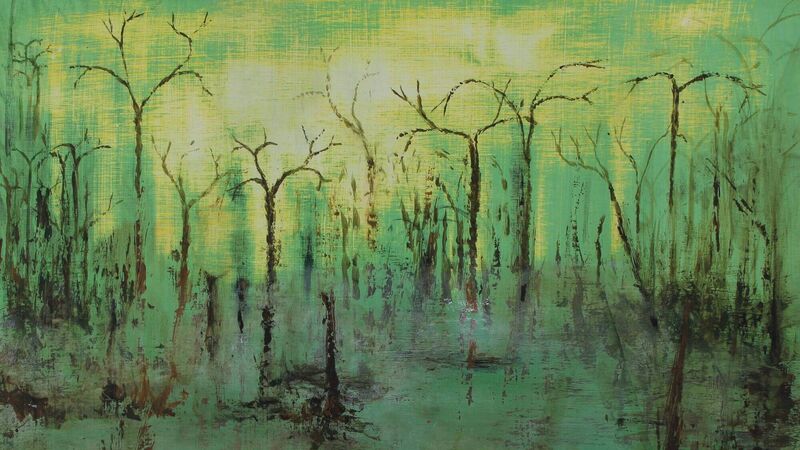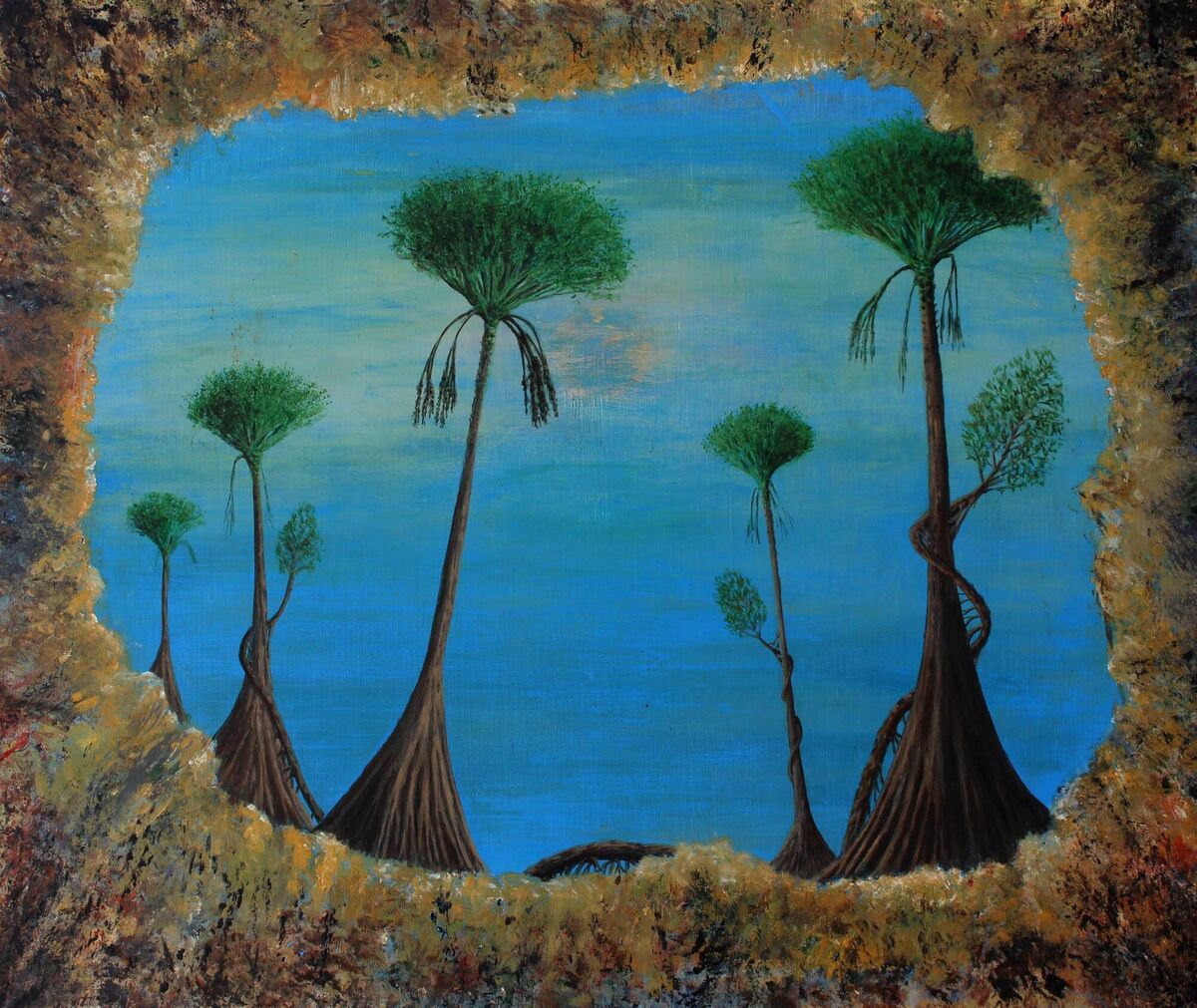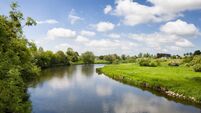Artists showcase work in new exhibition 'Shadow Forests'

Angela Gilmour's Lycopsids (first forests, 380 Ma, fossilised High Arctic), 2022, acrylic on FSC birch panel.
ONCE upon a time, Ireland was home to an extensive forest, with 80% of the island covered in trees - but today these have all but disappeared.
South-west of Macroom in County Cork lies The Gearagh, an ancient submerged glacial woodland and nature reserve, which was flooded in 1954 to facilitate the building of two hydro electric dams, one in Carrigadrohid and another in Inniscarra.
Although the vast oak trees are long since gone, what still remains is an evocative ghostly imprint of their former existence.
Along with three other ancient forests, The Cairo and Gilboa fossil forests of the Catskill mountains in New York state, as well as the ancient forest of Svalbard in the High Arctic, The Gearagh is the inspiration behind a current exhibition, Shadow Forests, at the Lord Mayor’s Pavilion in Cork running until April 23.

Shadow Forests is a multi media immersive installation and features the combined artistic expression of artist Angela Gilmour and writer Beth Jones, with work including painting, scientific drawings, digital stories and 3D models of ancient fossils.
In the exhibition, Angela and Beth have managed to capture the still lingering ethereal beauty from the presence of these former ancient forests.
This joint exhibition focuses on the intersections of ‘Deep Time’, the critical nature of climate change, and the life and death cycle of forests.
‘Deep Time’ refers to the time scale of geological events which stretch way further back from the measurement of the scale of human life, extending into millions of years back in time.
“It’s an extraordinary and quite frankly a very moving experience to stand beside the roots of 380 million year old trees, it’s mind- boggling actually,” said Beth, who is not only a digital storyteller, but also a journalist for The New York Times and The Boston Globe, as well as being an author and education consultant based in Boston.
“That amount of time is nearly impossible to imagine,” she said.

“In ‘Dreaming of Trees’, which is part of the exhibition, I was inspired by my visits to the visible fossil forest in New York’s Catskill mountains, along with a paleobotanist and a consultant geomorphologist.
“I was trying to imagine 385 million years into the future - and that’s a pretty tough thing to do!”
Her creative partner for this exhibition is Angela Gilmour, who lives and works as a visual artist in Macroom. She was formerly a practicing physicist, and holds a Masters in Science, an Honours Degree in Physics from the University West in Scotland, as well as an honours Degree in Fine Art from Crawford College in Cork, and has exhibited her work in Europe, Australia and America, as well as in Ireland.
The adventurous pair met each other in June, 2019, while on a residency programme in art and science sailing around in The Arctic Circle. During the expedition they travelled the waters of the international territory of Svalbard, an Arctic archipelago ten degrees south of the North Pole.
Shadow Forests is a response to their shared experience on The Arctic Circle residency programme, employing their field research, interviews and scientific investigations into ancient forests as a means of communicating topical events relating to the climate.

“It was an incredible experience sailing around the Svalbard with artists and scientists,” recalls Beth.
“It was spectacularly beautiful but also extraordinarily fragile and at risk from climate change.
“We were both very surprised at how warm it was while we were there, much warmer than average for an Arctic summer. The highest temperature ever recorded occurred while we were there,” she said, and indeed the temperature hit a startling 38 degrees in the Arctic that summer.
“The content of this exhibition was a steep learning curve for both of us,” said Angela. “We were privileged to be given access to the forests themselves, as well as research papers, images, and even one of the world’s most extensive fossil collections at the NY state museum.
“Ancient forests changed the composition of the environment removing CO2 and making the planet habitable, unfortunately we are going in the wrong direction now, putting more CO2 into the environment. We can’t exist without trees, we rely on them to regulate the atmosphere, stabilize the soil, and maintain a habitable temperature.

“My work process starts with a lot of research, and I read and digested a lot of scientific papers. Science and art have both been interests of mine since childhood. Even when I was studying physics, I took art classes at night.
“One of the interesting things I learned is that when the first forests arrived on the planet there were no flowers, no flying insects, and the only colours you would have seen were greens and browns.
"So in my painting I introduced colour by using sunsets and sunrises, the landscape changed in appearance depending on the angle of the sun on the horizon.”
Angela continues to be deeply inspired by The Gearagh.
“Living near the Gearagh National Park has inspired my work enormously. The Gearagh is a magical and haunting place. It’s dramatic and eerie. Its beauty changes so much with the weather and levels of water, sometimes it becomes almost lunar.
“It’s a fascinating place, but what is also important is that the eeriness is due to the trees having been removed long ago.”
The subject of refugees from both war and from climate change is something that Angela also continues to explore.
Her work also examines the extraction of natural resources and minerals from fragile environments, and she will continue exploring similar themes in upcoming exhibitions.

In the mid-nineties, Beth launched a mindfulness programme for the Harvard Medical school. She took an existing clinical programme in behavioural medicine and transformed it into a direct service programme to teach mindfulness to educators and students from pre through to high school.
When it comes to climate anxiety, she is extremely conscious of its impact upon young people.
“We need to acknowledge their fears without dismissing them, and also acknowledge how we and previous generations have taken resources for granted.
"We need to support their efforts, however big or small, in regard to creating a more just ecological future.
“We can help them by supporting climate and environmental justice warriors such as Greta Thunberg, and so many others around the world who recognise that the Earth as they know it is at risk.
“It is essential to learn the lessons that time teaches us. Understanding the deep past can lead to change in thought and action and positively impact the environment.
“It is our hope that Shadow Forests will draw attention to the critical nature of our existing woodlands and the importance of preserving them for the future.”







 App?
App?


